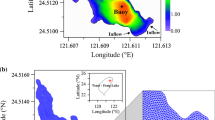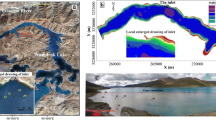Abstract
Suspended sediment in the lakes can impact the aquatic ecosystem and water resource management. A three-dimensional hydrodynamic and suspended sediment transport model was performed to simulate temporal and spatial variations of suspended sediment and applied to the subtropical subalpine Yuan-Yang lake of Taiwan. The model was validated with measured water level and suspended sediment concentration in 2009 and 2010. The overall model simulation results are in quantitative agreement with the available field data. The validated model was then used to find out the important parameter which affected the suspended sediment concentration and to investigate the effect of wind stress on mean current and suspended sediment distribution in the lake. Modeling results of sensitivity analysis indicate that the settling velocity plays a crucial parameter in the suspended sediment transport. The simulated results also show that the bottom currents are in opposite direction as surface currents due to return flows. Remarkable lake circulation was found and affected by the wind speed and direction. Mean suspended sediment concentration at the bottom layer is less than that at the top layer. Strong wind would result in higher mean current and mean suspended sediment distribution at the top layer. The wind stress plays a significant influence on mean circulation and suspended sediment transport in a shallow lake.












Similar content being viewed by others
References
Aalderink RH, Lijklema L, Breukelman J, Van Raaphorst W, Brinkman AG (1984) Quantification of wind induced resuspension in a shallow lake. Water Sci Technol 17:903–914
APHA (1995) Standard methods for the examination of water and wastewater, 19th edn. American Public Health Association, Washington, DC
Cardenas MP, Schwab DJ, Eadie BJ, Hawley N, Lesht BM (2005) Sediment transport model validation in Lake Michigan. J Great Lakes Res 31:373–385
Chalov SR, Jarsjo J, Kasimov NS, Romanchenko AO, Pietron J, Thorslund J, Promakhova EV (2015) Spatio-temporal variation of sediment transport in the Selenga River Basin, Mongolia and Russia. Environ Earth Sci 73:663–680
Chao X, Jia Y, Shields FD Jr, Wang SSY, Cooper CM (2007) Numerical modeling of water quality and sediment related processes. Ecol Model 201:297–385
Chao X, Jia Y, Shields FD Jr, Wang SSY, Cooper CM (2008) Three-dimensional numerical modeling of cohesive sediment transport and wind wave impact in a shallow oxbow lake. Adv Water Resour 31:1004–1014
Chen WB, Liu WC, Hsu MH, Hwang CC (2015) Modelling investigation of suspended sediment in a tidal estuary using a three-dimensional model. Appl Math Model 39:2570–2586
Chung EG, Bombardelli FA, Schladow SG (2009) Modeling linkages between sediment resuspension and water quality in a shallow, eutrophic, wind-exposed lake. Ecol Model 220:1251–1265
Galperin B, Kantha LH, Hassid S, Rosati A (1988) A quasi-equilibrium turbulent energy model for geophysical flows. J Atmos Sci 45:55–62
Hamrick JM (1992) Estuarine environmental impact assessment using a three-dimensional circulation and transport model. In: Spaulding ML et al. (eds) Proceedings of 2nd international conference on Estuarine and coastal modeling, American Society of Civil Engineers, New York, pp 292–303
Hamrick JM, Wu TS (1997) Computational design and optimization of the EFDC/HEM3D surface water hydrodynamic and eutrophication models. Next generation environmental models and computational methods, Delic G and Wheeler MF (eds) Society for Industrial and Applied Mathematics, Philadelphia
Hawley N, Harris CK, Lesht BM, Clites AH (2009) Sensitivity of a sediment transport model for Lake Michigan. J Great Lakes Res 35:560–576
Houwing ER, Rijn LC (1998) In situ erosion flume (ISEF): determination of bed-shear stress and erosion of a kaolinite bed. J Sea Res 39:243–253
Hutter K, Bauer G, Wang Y, Gutingg P (1998) Forced motion response in enclosed lake. Coast Estuar Stud 54:137–166
Ji ZG, Hamrick JH, Pagenkopf J (2002) Sediment and metals in shallow river. J Environ Eng 128:105–119
Jin KR, Ji ZG (2004) Case study: modeling of sediment transport and wind-wave impact in Lake Okeechobee. J Hydraul Eng 130:1055–1067
Kimura N, Liu WC, Chiu CY, Kratz TK, Chen WB (2012) Real-time observation and prediction of physical processes in a typhoon-affected lake. Paddy Water Environ 10:17–30
Kimura N, Liu WC, Chiu CY, Kratz TK (2014) Assessing the effects of severe rainstorm-induced mixing on a subtropical, subalpine lake. Environ Monit Assess 186:3091–3114
Kjaran SP, Holm SL, Myer EM (2004) Lake circulation and sediment transport in Lake Myvatn. Aquat Ecol 38:145–162
Kocyigit MB, Falconer RA (2004) Three-dimensional numerical modeling of wind-driven circulation in a homogeneous lake. Adv Water Resour 27:1167–1178
Krone RB (1962) Flume studies on the transport of sediment in estuarine shoaling processes. Hydraulic Engineering Laboratory, University of California, Berkeley
Kumagai M (1988) Predictive model for resuspension and deposition of bottom sediment in lake. Jpn J Limnol 49:185–200
Lee C, Schwab DJ, Hawley N (2005) Sensitivity analysis of sediment resuspension parameters in coastal area of southern Lake Michigan. J Geophys Res 110:C03004
Lee C, Schwab DJ, Beletsky D, Stroud J, Lesht B (2007) Numerical modeling of mixed sediment resuspension, transport, and deposition during the March 1988 episodic events in southern Lake Michigan. J Geophys Res 112:C02018
Li Y, Mehta AJ (1998) Assessment of hindered settling of fluid mudlike suspensions. J Hydraul Eng 124:176–178
Liu WC (2005) Modeling the influence of settling velocity on cohesive sediment transport in Tanshui River estuary. Environ Geol 47:535–546
Liu WC, Lee CH, Wu CH, Kimura N (2009) Modeling diagnosis of suspended sediment in tidal estuarine system. Environ Geol 57:1661–1673
Lv C, Zhang F, Liu Z, Hao S, Wu Z (2013) Three-dimensional numerical simulation of sediment transport in Lake Tai based on EFDC model. J Food Agric Environ 11:1343–1348
Mehta AJ, Partheniades E (1975) An investigation of the depositional properties of flocculated fine sediment. J Hydraul Res 13:361–381
Mehta AJ, Hayter EJ, Parker WR, Krone RB, Teeter AM (1989) Cohesive sediment transport I: process description. J Hydraul Eng 115:1076–1093
Mellor GL, Yamada T (1982) Development of a turbulence closure model for geophysical fluid problems. Rev Geophys 20:851–875
Murphy AH (1988) Skill score based on the mean square error and their relationship to the correlation coefficient. Mon Weather Rev 116:2417–2424
Partheniades E (1965) Erosion and deposition of cohesive soils. J Hydraul Div ASCE 91:105–139
Podsetchine V, Huttula T (1994) Modeling sedimentation and resuspension in lake. Water Pollut Res Can 29:309–342
Scheon J, Stretch D, Tirok K (2014) Wind-driven circulation patterns in shallow estuarine lake: st Lucia, South Africa. Estuar Coast Shelf Sci 146:49–59
Smolarkiewicz PK, Grabowski WW (1990) The multidimensional positive definite advection transport algorithm: nonoscillatory option. J Comput Phys 86:355–375
Smolarkiewicz PK, Margolin LG (1993) On forward-in-time differencing for fluids: extension to curvilinear framework. Mon Weather Rev 121:1847–1859
Stroud JR, Lesht BM, Schwab DJ, Beletsky D, Stein ML (2009) Assimilation of satellite imagines into a sediment transport of Lake Michigan. Water Resour Res 45:W02419
Thomann RV, Mueller JA (1987) Principles of surface water quality modeling and control. Harper Collins Publishers Inc, New York
Thorn MFC (1981) Physical processes of siltation in tidal channels. In: Proceedings of hydraulic modelling applied to maritime engineering problems, London, ICE, pp 47–55
Tsai JW, Kratz TK, Hanson PC, Wu JZ, Chang WYB, Arzberger PW, Lin BS, Lin FP, Chou HM, Chiu CY (2008) Seasonal dynamics, typhoons and the regulation of lake metabolism in a subtropical humic lake. Freshw Biol 53:1929–1941
Wang C, Shen C, Wang PF, Qian J, Hou J, Liu JJ (2013) Modeling of sediment and heavy metal transport in Taihu lake, China. J Hydrodyn 25:387–397
Young SM, Ishiga H (2014) Environmental change of the fluvial-estuary system in relation to Arase Dam removal of the Yatsushiro tidal flat, SW Kyushu, Japan. Environ Earth Sci 72:2301–2314
Ziegler CK, Nisbet BS (1994) Fine-grained sediment transport in Pawtuxet River, Rhode Island. J Hydraul Eng 120:561–576
Ziegler CK, Nisbet BS (1995) Long-term simulation of fine-grained sediment transport in large reservoir. J Hydraul Eng 121:773–781
Zouabi-Aloui B, Gueddari M (2014) Two-dimensional modelling of hydrodynamics and water quality of a stratified dam reservoir in the southern side of the Mediterranean Sea. Environ Earth Sci 72:3037–3051
Acknowledgments
This research was founded by the Academia Sinica, Taiwan (No. AS-103-TP-B15). The financial support is greatly appreciated. The authors sincerely thank three anonymous reviewers for their valuable comments which substantially improved this paper.
Author information
Authors and Affiliations
Corresponding author
Rights and permissions
About this article
Cite this article
Liu, WC., Chan, WT. & Tsai, D.DW. Three-dimensional modeling of suspended sediment transport in a subalpine lake. Environ Earth Sci 75, 173 (2016). https://doi.org/10.1007/s12665-015-5069-0
Received:
Accepted:
Published:
DOI: https://doi.org/10.1007/s12665-015-5069-0




